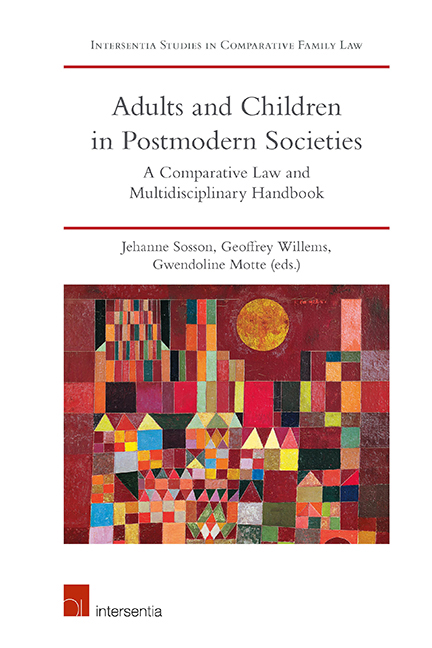Book contents
- Frontmatter
- Contents
- List of Cases
- List of Contributors
- Introduction
- PART I NATIONAL REPORTS ON LEGAL REGULATIONS OF RELATIONSHIPS BETWEEN ADULTS AND CHILDREN
- PART II INTERDISCIPLINARY APPROACH
- PART III INTERNATIONAL LAW INSIGHTS
- PART IV COMPARATIVE APPROACH
- Parentage, Parenthood and Parental Responsibility in Traditional Families
- Emergence and Development of Artificial Reproductive Technologies
- Multiplication of Potential Social and Emotional Ties
- The Future of Legal Relationships between Adults and Children: Complex Issues and Hybrid Solutions
- General Conclusion: The Challenge of Transparent and Inclusive Parenthood/Parentality in a Pluralist and Cosmopolitan Context
- About the Editors
Parentage, Parenthood and Parental Responsibility in Traditional Families
from PART IV - COMPARATIVE APPROACH
Published online by Cambridge University Press: 26 June 2019
- Frontmatter
- Contents
- List of Cases
- List of Contributors
- Introduction
- PART I NATIONAL REPORTS ON LEGAL REGULATIONS OF RELATIONSHIPS BETWEEN ADULTS AND CHILDREN
- PART II INTERDISCIPLINARY APPROACH
- PART III INTERNATIONAL LAW INSIGHTS
- PART IV COMPARATIVE APPROACH
- Parentage, Parenthood and Parental Responsibility in Traditional Families
- Emergence and Development of Artificial Reproductive Technologies
- Multiplication of Potential Social and Emotional Ties
- The Future of Legal Relationships between Adults and Children: Complex Issues and Hybrid Solutions
- General Conclusion: The Challenge of Transparent and Inclusive Parenthood/Parentality in a Pluralist and Cosmopolitan Context
- About the Editors
Summary
INTRODUCTION
From a socio-historical perspective, procreation within a heterosexual couple has for a long time been the only socially accepted and legally organised way of founding a family. While deep changes have taken place in the last decades due to substantial sociological changes and the advent of assisted reproduction techniques, and while relationships between adults and children now take place in very different family contexts, today many children still live in what can be called ‘traditional’ families formed by a man and a woman procreating a child and becoming parents through ‘natural’ procreation in the framework of a nuclear family.
The first part of the research questionnaire and of the national reports published in this book focuses on the current regulation and legal recognition/ protection of adult – child relationships in the traditional nuclear family.
Who is legally the mother and the father of a child? With what legal consequences? How, and to what extent, are these relationships protected? Are some relations with other relatives also secured and if so, how?
MATERNITY
In all the surveyed jurisdictions, legal motherhood basically derives from the fact that the mother gave birth to the child. Therefore, in ‘traditional’ families, the genetic link with the child determines maternity. Moreover, or maybe consequently, none of the reviewed jurisdictions makes a difference between married and unmarried women as regards legal maternity.
In all jurisdictions, except Sweden, a birth certificate has to be issued after the child's birth.
Everywhere, the naming of the mother on the birth certificate is a way to document or establish legal maternity. Some jurisdictions consider that a woman is legally the mother by having given birth to the child and being the biological parent; maternity is then established as a fact and the birth certificate is (just) evidence of this fact. In another set of countries (Algeria, Belgium, France, Italy, Romania), being named on the birth certificate appears to be a legal way of establishing motherhood, as without this mention, the woman who gave birth will not be the legal mother; the child's legal relationship with the mother depends on her name as recorded in the register of births or on the birth certificate.
- Type
- Chapter
- Information
- Adults and Children in Postmodern SocietiesA Comparative Law and Multidisciplinary Handbook, pp. 725 - 758Publisher: IntersentiaPrint publication year: 2019



